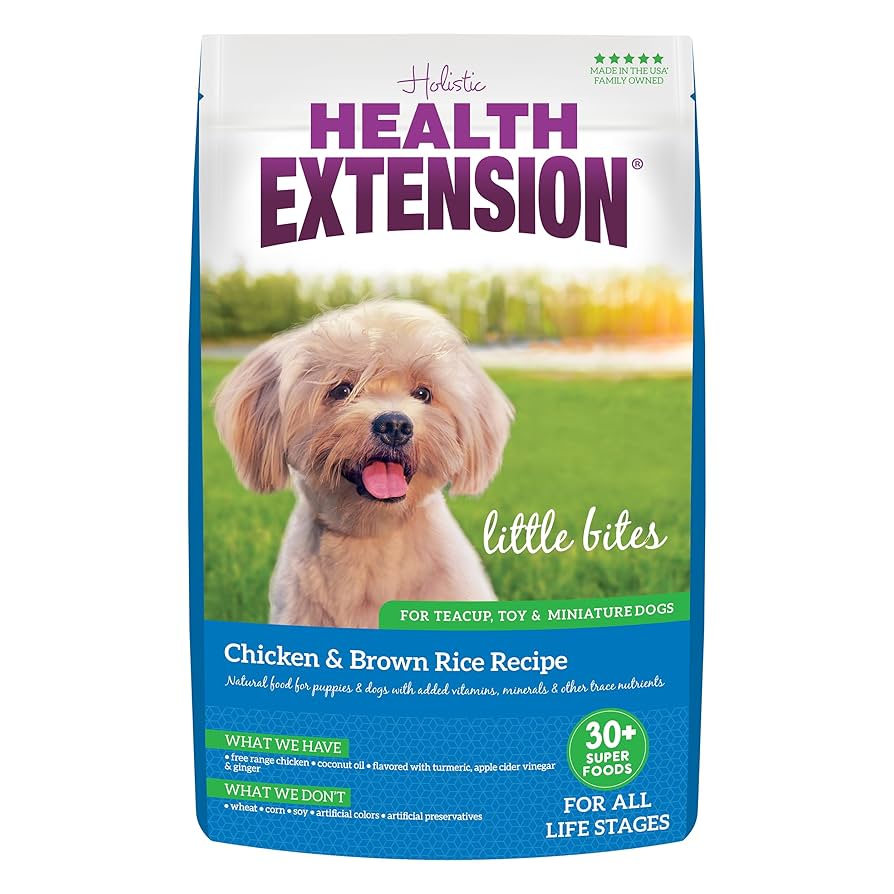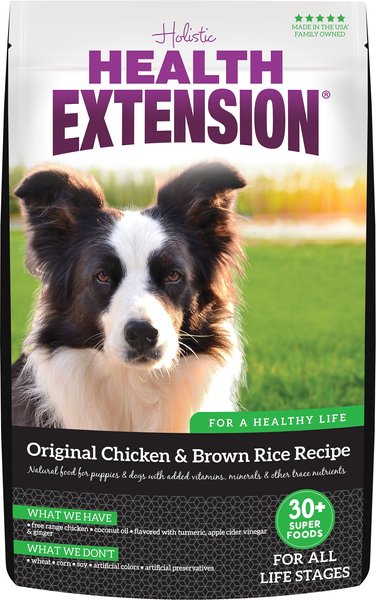I’ve spent years helping pet parents sort through labels and marketing claims. Health Extension dog food stands out for its balanced recipes, clear labeling, and thoughtful add-ins like probiotics and omega-3s. If you want a diet that blends whole-food ingredients with sound nutrition, Health Extension dog food is worth a close look. In this guide, I’ll break down what’s inside, who it’s best for, and how to pick the right formula with confidence.

What Is Health Extension Dog Food?
Health Extension is a family-owned brand known for recipes that avoid common fillers. Many formulas are free from corn, wheat, soy, and artificial preservatives. Most meet AAFCO standards for complete and balanced nutrition for growth or maintenance.
Key points to know:
- Uses real meat as the first ingredient in most lines.
- Offers grain-inclusive and grain-free choices.
- Includes functional add-ons like probiotics, turmeric, and joint support in select recipes.
- Covers all life stages, from puppy to senior.
In short, it aims to deliver quality nutrition without the fluff, at a mid-range price point.

Ingredient Philosophy And Sourcing
Health Extension leans on simple, recognizable ingredients. You’ll often see chicken, turkey, salmon, or lamb paired with brown rice, oatmeal, or chickpeas. Many formulas add flaxseed and salmon oil for omega-3s. Some include superfoods like coconut oil and apple cider vinegar.
What I look for on the label:
- Named proteins. For example, “deboned chicken” over vague terms.
- Complex carbs like brown rice or sweet potato for steady energy.
- Natural preservatives such as mixed tocopherols.
- Probiotics and prebiotic fiber to support digestion.
Expert note: AAFCO-compliant recipes ensure essential amino acids, vitamins, and minerals are present at the right levels. That is the baseline for safety and balance.

Product Lines And Who They Fit
Health Extension offers several lines. Choose based on your dog’s age, size, and sensitivities.
- Original grain-inclusive kibble: Good for most healthy adult dogs who do well with grains.
- Grain-free kibble: Useful for dogs who do not tolerate certain grains. Note: Grain-free is not automatically better.
- Limited ingredient diets: Helpful for dogs with food sensitivities. Fewer proteins and carbs mean easier elimination trials.
- Puppy formulas: Extra protein, fat, DHA, and calcium support growth.
- Small breed and large breed: Adjusted kibble size and joint support to fit breed needs.
- Wet foods and toppers: Add palatability and moisture for picky eaters or dogs needing hydration.
Tip: Match the formula to your dog’s life stage and activity level first, then refine for taste or sensitivities.

Nutrition Deep Dive: Macros And Micros
Most Health Extension dog foods fall in a moderate protein and fat range, with balanced carbs. That supports steady energy and lean muscle.
What matters most:
- Protein quality: Animal-based proteins supply key amino acids like lysine and methionine.
- Fat profile: Salmon oil and flaxseed boost EPA and DHA, which help skin, coat, and cognitive health.
- Fiber: Beet pulp, pumpkin, and prebiotics can improve stool quality.
- Micronutrients: Chelated minerals may improve absorption. Vitamins A, D, E, and B complex support immune and metabolic health.
- Joint support: Some large-breed and senior recipes add glucosamine and chondroitin.
▶️ Evidence check: Research supports omega-3s for skin health and inflammation control, and probiotics for digestive support in dogs.

Common Benefits Reported
From my work with pet parents, I see these wins most often:
– Better stool quality after a steady 2 to 3 weeks.
– Shinier coat and reduced itch in dogs that needed more omega-3s.
– More consistent appetite thanks to palatable recipes.
– Good weight control when paired with measured portions and daily walks.
Remember that results vary. Nutrition is personal.
Potential Drawbacks And How To Decide
No brand is perfect. Watch for these points:
– Grain-free debate: Some dogs need grains. Grain-free diets are not a cure-all. Talk to your vet if your dog has heart concerns.
– Calorie density: Some recipes are energy-dense. Overfeeding can sneak up fast.
– Protein sources: If your dog is sensitive to chicken, choose single-protein recipes like salmon or lamb.
How to decide:
- Start with your vet’s input, especially for puppies, seniors, or dogs with medical conditions.
- Read the guaranteed analysis and ingredient list, not only the front label.
- Trial for 6 to 8 weeks and track stool, energy, coat, and weight.
How To Transition And Feed Right
A slow switch helps the gut adjust.
7-day transition plan:
- Days 1 to 2: 75% old food, 25% Health Extension.
- Days 3 to 4: 50% old, 50% new.
- Days 5 to 6: 25% old, 75% new.
- Day 7: 100% new.
Feeding tips:
- Measure portions based on the bag guide and your dog’s body condition.
- Split meals twice a day to stabilize energy.
- Add water or warm broth to kibble for picky eaters.
- Use a slow feeder if your dog gulps food.
Real-World Results: My Notes From The Field
Here are a few patterns I’ve seen:
– Sensitive stomachs: Dogs with soft stool often firm up on recipes with pumpkin, beet pulp, and probiotics.
– Itchy skin: Coat shine improved with salmon-based formulas and added fish oil.
– Picky eaters: Mixing a spoon of Health Extension wet food with kibble raised acceptance.
– Weight control: The grain-inclusive lines with moderate fat helped maintain ideal weight when owners measured portions.
Lessons learned:
- Do not change too fast. The gut needs time.
- Track weight every two weeks. Adjust portions by 5% to 10% as needed.
- One success story does not mean it fits every dog. Stay observant and flexible.
Cost, Value, And Where To Buy
Health Extension sits in the mid-range pricing tier. It is often better value than boutique brands with similar ingredients.
Smart ways to save:
- Buy larger bags if you can keep them fresh in airtight bins.
- Use autoship discounts from reputable retailers.
- Pair with simple, healthy toppers like plain pumpkin to boost fiber without higher costs.
You can find it online and in many independent pet stores.
How It Compares To Alternatives
Compared to budget kibbles:
– Usually higher-quality proteins and fewer fillers.
– More functional add-ins like probiotics and omega-3s.
Compared to premium or fresh diets:
- Lower cost and longer shelf life.
- Not as high moisture as fresh food. You can add water or wet toppers to bridge the gap.
When to choose Health Extension:
- You want solid nutrition with clean labels.
- Your dog benefits from moderate protein and added digestive support.
- You prefer a brand with both grain-inclusive and grain-free options.
Safety, Recalls, And Quality Control
Health Extension states that it uses strict quality checks and follows AAFCO standards. Recalls can occur in any brand. Always stay updated via the FDA pet food recall list and your retailer’s alerts.
How to protect your dog:
- Store food in its original bag inside an airtight bin.
- Note the lot number and best-by date.
- If you see odor changes, moisture, or pests, do not feed it.
- Introduce a new bag by mixing it with the last of the old bag for one or two meals to watch for changes.
Frequently Asked Questions Of Health Extension Dog Food
Q. Is Health Extension Dog Food Good For Sensitive Stomachs?
Many dogs with mild digestive issues do well on recipes with probiotics, beet pulp, and pumpkin. Try a limited ingredient or single-protein formula and transition slowly.
Q. Should I Choose Grain-Free Or Grain-Inclusive?
Most dogs do well with grains. Pick grain-free only if your vet suggests it or your dog shows clear signs of grain intolerance. Balance and digestibility matter more than labels.
Q. How Do I Know Which Protein Is Best?
Start with what your dog tolerates now. If chicken caused issues before, try salmon or lamb. Keep a journal of stool, itchiness, and energy during the trial.
Q. Can I Mix Health Extension With Wet Food Or Fresh Toppers?
Yes. Mixing can raise moisture and palatability. Adjust the total calories to avoid weight gain. Keep toppers simple and dog-safe.
Q. Does Health Extension Meet AAFCO Standards?
Yes, their complete and balanced recipes are formulated to meet AAFCO nutrient profiles for growth or maintenance. Check the label for your dog’s life stage.
Q. How Long Until I See Results?
Many owners notice changes in stool and coat within 2 to 4 weeks. Joint and skin benefits from omega-3s may take 6 to 8 weeks.
Conclusion
Health Extension dog food delivers balanced nutrition with thoughtful ingredients and real-world results. If you want a reliable, mid-range option with clean labels and functional add-ins, it is a strong candidate. Start with the right life-stage formula, transition with care, and track your dog’s response.
Ready to take the next step? Choose a formula that matches your dog’s needs, try a measured 8-week trial, and keep notes. If you found this helpful, subscribe for more pet nutrition guides or leave a question in the comments.
Watch This Video on health extension dog food
